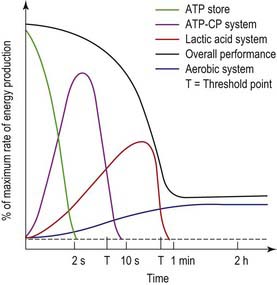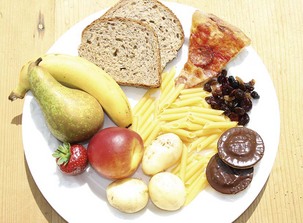Chapter 3 Nutrition
ENERGY FOR EXERCISE
We all need energy for exercise. Energy is the basic requirement for any form of activity.
Energy production
The unit of energy is ATP (adenosine triphosphate) which when broken down releases energy. There are three systems of releasing energy from ATP which work together to provide the energy requirement depending on what exercise regime is being followed.1
Some athletic events require purely one energy system to be utilised but most require a combination of all three (Fig. 3.4). Training fine tunes the efficiency of each system appropriate to the event which is being trained for.
INGREDIENTS FOR ENERGY
The different types of energy sources and their sub-divisions can be confusing and distracting. The three sources of energy are as follows2:
Carbohydrates
The bulk of carbohydrate should come from cereals or starchy food sources such as:
The remainder is gained from sugar, fruits and juices.
The speed with which the glucose is absorbed into the blood stream and hence its availability as a substrate for energy release is also a factor in your choice of carbohydrate foods. The glycaemic index (GI)3 is a measure of this. Highly absorbed carbohydrates have a high GI index and poorly absorbed ones have a low GI index. The high GI foods are useful to take as recovery after exercise when carbohydrate stores need to be re-stocked quickly, and low GI foods, which have higher fibre contents, release their energy sources more slowly. Examples of high and low GI foods are shown in Table 3.1.
Table 3.1 High and low GI foods
| High GI | Low GI | |
|---|---|---|
| Breads | Bagel, wholemeal | Granary, rye bread |
| Cereals | Bran flakes, Weetabix | Muesli, All-bran |
| Starches | Baked/mashed potato | Pasta, lentils |
| Fruit | Watermelon | Apple, peach, pear |
| Snacks | Jelly beans, rice cakes | Sultanas, Mars bar |
| Drinks | Sports drinks (isotonic) | Apple/Orange juice |
Timing of carbohydrate intake
The timing of when you take the carbohydrate also plays a role in its absorption. Athletes need to experiment with this and it is important to remember that the total carbohydrate intake is the most essential factor.4
Before training – take a large meal of high carbohydrate content 2–4 h before training, topped up by a high GI carbohydrate load 30–60 min before. Some athletes do experience gastrointestinal upset with some high GI loads, so do experiment with these, e.g. chicken in pasta with jelly babies, 30 min before training.
During training of more than 1 h duration – take 600–1000 mL of a moderately high GI sports drink that provides fluid as well as carbohydrate loading.
After training – there is a 1–2 h ‘window of opportunity’ after intensive training when the muscles are particularly receptive to replenishing their stores of glycogen. It is useful to use this time to take in high GI foods to maximise muscle re-fuelling. This is especially important if there is a short gap between training sessions.
Stay updated, free articles. Join our Telegram channel

Full access? Get Clinical Tree



















